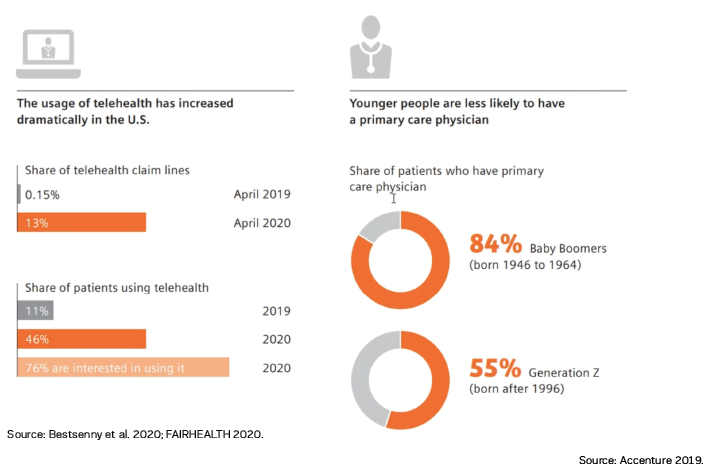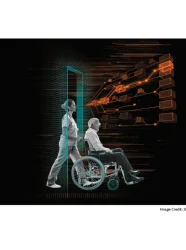Herbert Staehr serves as Global Head of Transforming Care Delivery for Siemens Healthineers, driving the company’s activities and messaging around delivering high-value care. In this capacity, he develops and executes programmes and outreach strategies aimed at healthcare providers around the world, as well as stakeholders in every branch of the healthcare industry. HealthManagement.org spoke to Dr Staehr about digitalisation in healthcare and its challenges, benefits, and impact on care delivery and access and patient satisfaction.
The COVID-19 pandemic has accelerated digitalisation in healthcare. Why do you think healthcare needed this push?
The ability of health systems to engage virtually with patients, assess their needs and direct them towards treatment and care is not new, but it has been slow to gain traction. Change, after all, is hard, and between an attachment to brick and mortar facilities and concerns about regulations, reimbursement, privacy, and existing workflows/ routines, the reasons for not embracing digital front doors have been understandable and numerous enough to slow their adoption.
COVID-19 changed that and the adoption of ‘digital front doors’ – as we called them in a recent thought leadership paper – has been accelerating. The pandemic didn’t just illuminate the limitations of the ‘human gatekeeper’ at healthcare’s front door; it made that model, at least for a time, impossible or simply too risky.
With so many patients to manage, the pandemic created such profound fears about infection that people– even those with serious health concerns – stayedaway from emergency departmentsand other healthcare facilities. Many of them turned instead to telehealth, or digital front doors, testing them for the first time – and appreciating what they found.


What are the primary benefits of digitalisation in healthcare?
What patients
have found in virtual care is a healthcare model that allows them to consult
with providers regardless of where they or the providers are located, and
provides them with online tools that allow them to monitor and manage their own
care.
What providers have found is a model that is both flexible and scalable, and allows them to direct their patients towards the care they need, engage with them from any distance, monitor their progress and manage their care.
The benefits result in a vast potential for digital front doors. A McKinsey & Company study estimates, that 20% of ED visits and 24% of office and outpatient visits could be shifted to virtual care delivery. The question will be how quickly providers are able to adapt and begin offering these services. In the context of virtual care, service areas as they once existed are not particularly relevant, so the market for patients is wide open. If providers are able to adapt their existing digital infrastructure, adjust workflows, manage data, and obtain buy-in from both their workforce and patients, a very bright future lies ahead. It is simply a question of unlocking the door.
Healthcare has always been a human-centred profession. Do you think this aspect will be lost with increasing digitalisation?
For as long as there have been doctors and nurses, the basic healthcare interaction has been a very human one. When a person feels sick or suffers an injury, they visit a healthcare provider. This traditional, “physical” human gatekeeper has served healthcare well for generations, but in today’s world the limitations of this system are becoming more and more apparent.
Patients are
increasingly approaching healthcare as “consumers” and demanding the same fast,
convenient, easy and affordable service they have come to expect in other areas
of their lives. In an era characterised by on-demand services, rapid delivery
and instant communication, the focus lies on convenient satisfaction of the
needs at hand, less on doing so in-person.In the end, the ‘human element’ will
not be lost – it will simply be offered over different channels and
platforms. It’s still people - not
robots or computers - that patients are interacting with.
Digitalisation will require existing systems to upgrade themselves. This will cost money. How do you think traditional healthcare systems can generate funding? And do you think such investments will be worth it in the long run?
To be both easily accessible and usable, digital front doors will need to be integrated into existing infrastructure. That will require investments into new hardware for providers (e.g., smart devices, tablets, etc.), and software. Improved wireless capabilities (e.g., a move to 5G), may also help to provide the needed connectivity. Data storage will pose a challenge for many, with a shift to cloud-based data storage offering a potential solution. The costs for infrastructure and technology upgrades such as these, as well as related training, could prove to be an initial barrier for many organisations. Opportunities for flexible funding alternatives or partnership models might help to ease these pressures. Vendors with the relevant experience could be valuable partners during such transitions.And most of the patients (or consumers) have already made necessary investments and are embracing smart phones, tablets, etc. on their end. If healthcare providers don’t follow, they will likely be left behind.
Patients are no longer "patients". They are consumers demanding faster, better, cheaper care. How do you think digital tools can help tackle this new patient mindset and improve patient satisfaction?
This interest in, and acceptance of, virtual care is beginning to influence patients’ selection of healthcare providers. Increasingly, patients expect digital capabilities and are more likely to choose a healthcare provider who offers prescription refills electronically, reminders via email or text message, email communication, online appointment bookings, as well as telemonitoring or tele-consultation. Younger patients are less satisfied with the traditional ways of accessing healthcare and are more willing to try non-traditional services such as virtual health.
Two Accenture studies show that 84% of baby boomers have a primary care physician, whereas amongst members of Generation Z – those born after 1996 – this figure drops to 55%. Moreover, 41% of Generation Z report that they prefer a virtual or digital experience with their healthcare professional while for Baby Boomers this number drops to 9%.
Any successful healthcare endeavour depends on patients. Digital front doors are no different. Patient buy-in is essential. In the case of older patients, many of whom suffer from chronic diseases, real-time monitoring and easier access to physicians can have a positive impact on unplanned readmissions, quality of life and mortality. However, as older people are not always comfortable with new technology, stronger engagement and education effort may be required. In the case of younger patients who are familiar and comfortable with new technologies, this education process will be easier. However, because of the nature of digital care, patients will almost certainly have different options and different providers to choose from. It is quite possible, in fact, that more comparison websites and portals will emerge, helping patients navigate what is in effect a provider marketplace and identifying those provider that satisfy their needs best.
Do you think the entry of companies like Amazon, Google, Walmart and others in healthcare is a good sign or can this disrupt existing systems?
Healthcare used to be an industry with high barriers to entry. This is beginning to change with the emergence of more digital healthcare. Through virtual health technologies, new entrants as well as existing healthcare providers are now able to reachpatients almost anywhere. The reverse is equally true: providersand new players, located almost anywhere, are now able to reach and compete for patients.
From a patient or consumer viewpoint, additional competition will likely be positive. It allows more freedom of choice as well as more convenient and consumer-focused service models. And this might lead to overall cost-savings, higher service quality and outcomes.
How can the challenge of privacy and security of patient data be addressed with increased digitalisation in healthcare?
Issues of security and confidentiality are of increasing concern to all consumers, and medical data is particularly sensitive. These issues must be addressed in an effective and comprehensive way, not only at the level of individual providers but also at a broader regulatory or legislative level. A properly integrated healthcare system will depend on the ability of providers of all types to share information, and patients must have confidence that their digital data is being treated securely. Internal data security governance capabilities are essential, as well as a thorough understanding of data flows in order to proactively anticipate potential security vulnerabilities.
What new role(s) will employees have? How can they be
involved in this transition?
The first priority in any healthcare undertaking is patients; the second must be caregivers. The move to more digitalisation in healthcare is not about cutting jobs. People will continue to be essential; however their roles and the way they deliver care will evolve. Digitalisation offers benefits for employeestoo - think for instance about greater flexibility and more seamless workflows.
In the case of digital front doors, existing employees need to be empowered to leverage the new technology.They will actively seek change, once they see how the new digital options allow more flexibility in their workplaces as well as better patient outcomes. This will create incentives and motivation which are crucial during the change process. In addition, additional staff and experts will likely be required. As a larger part of the infrastructure is going to become digital, digital experts will be required to maintain it and help realisethe associated benefits.
References:
Bestsennyy O, Gilbert G, Harris A, Rost J (2019) Telehealth: A quarter-trillion-dollar post-COVID-19 reality? Available from https://www.mckinsey.com/industries/healthcare-systems-and-services/our-insights/telehealth-a-quarter-trillion-dollar-post-covid-19-reality
How digital tools are expanding access to healthcare. Insights Series, issue 19: Unlocking the digital front door. Siemens Healthineers. Available from https://www.siemens-healthineers.com/insights/insights-series?stc=wwhc221258
Millennial and Gen Z Consumers Paving the Way for Non-Traditional Care Models, Accenture Study Finds. Available from https://newsroom.accenture.com/news/millennial-and-gen-z-consumers-paving-the-way-for-non-traditional-care-models-accenture-study-finds.htm








